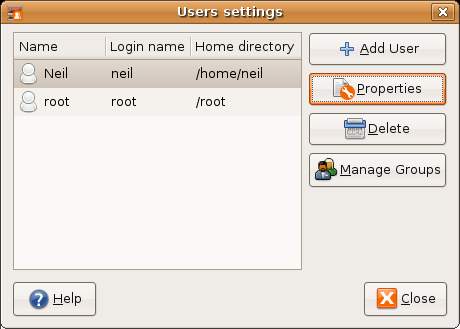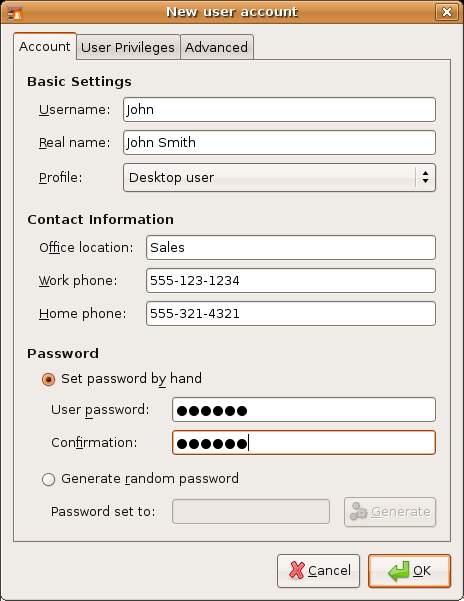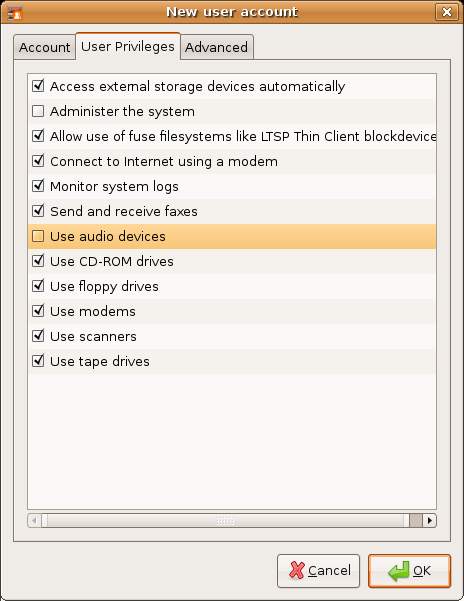Difference between revisions of "Managing Ubuntu Linux Users and Groups"
(→Adding a User to an Ubuntu Linux System) |
(→Adding a User to an Ubuntu Linux System) |
||
| Line 22: | Line 22: | ||
De-select any privileges you do not wish the new user to have. In particular you will wna to ensure the user does not have ''Administration'' privilege unless the user is a trusted system administrator. The other privileges are usually considered to be safe for the typical user. | De-select any privileges you do not wish the new user to have. In particular you will wna to ensure the user does not have ''Administration'' privilege unless the user is a trusted system administrator. The other privileges are usually considered to be safe for the typical user. | ||
| + | |||
| + | The final screen on the ''Add user dialog'' allows ''Advanced''' settings to be defined. These include such issues as the home directory of the user (traditionally /usr/''username''), tyhe type of shell that is presented as the command line in a terminal window (Bash is usually tyhe default), the group to which the user belongs and the user ID. Use the drop down group menu to change the user's group membership to a different group: | ||
| + | |||
| + | [[Image:Exampl.jpg]] | ||
== Deleting a User from an Ubuntu Linux System == | == Deleting a User from an Ubuntu Linux System == | ||
Revision as of 14:29, 5 July 2007
Linux is a multi-user operating system. This means that more than one user can be actively logged and using the system at any one time. Obviously, it makes sense for each user to have their own user account and home directory, and for different users to have different privileges.
Users are further divided into groups for the purposes of easier administration and those groups can have different levels of privileges. For example, you may have a group of users who work in the Accounting department. In such an environment you may wish to create an accounts group and assign all the the Accounting department to that group.
In this chapter we will cover the steps to add, remove and manage users and groups on an Ubuntu Linux system.
Adding a User to an Ubuntu Linux System
There are two methods for adding new users to a system, one way is using the graphical User Settings tool and the other is to use the adduser command-line tool. In this section we will look at both approaches.
To add a new user to your Ubuntu Linux system using the User settings tool select System desktop menu and choose Users and Groups from the Administration sub-menu. A dialog similar to the one shown below will appear:
To add a new user click on the Add User button. The New user account dialog will subsequently appear ready to be filled in with data relating to the new user, such as real name, account login name and contact information:
To define the privileges for this new user select the Privileges tab of the New user account dialog to display the privileges screen:
De-select any privileges you do not wish the new user to have. In particular you will wna to ensure the user does not have Administration privilege unless the user is a trusted system administrator. The other privileges are usually considered to be safe for the typical user.
The final screen on the Add user dialog allows Advanced' settings to be defined. These include such issues as the home directory of the user (traditionally /usr/username), tyhe type of shell that is presented as the command line in a terminal window (Bash is usually tyhe default), the group to which the user belongs and the user ID. Use the drop down group menu to change the user's group membership to a different group:






